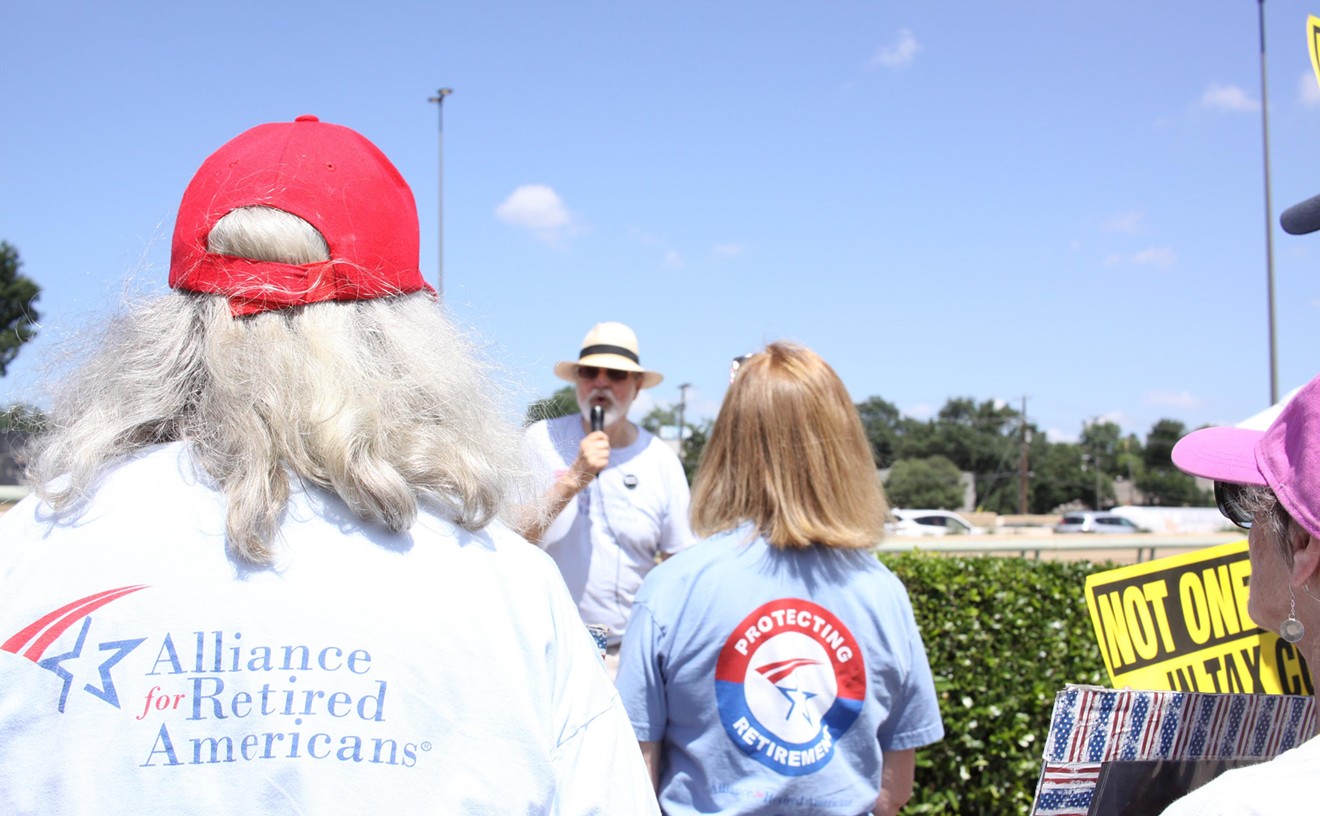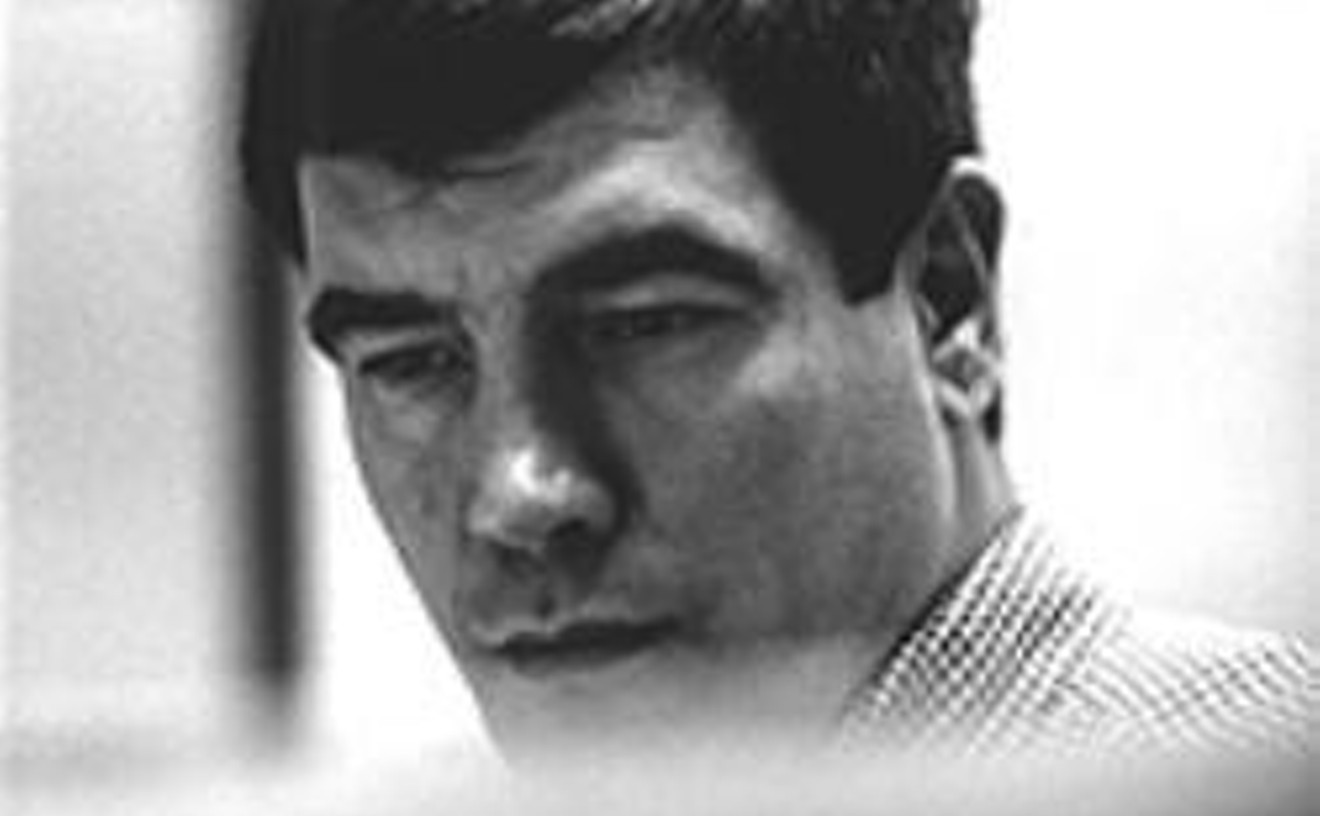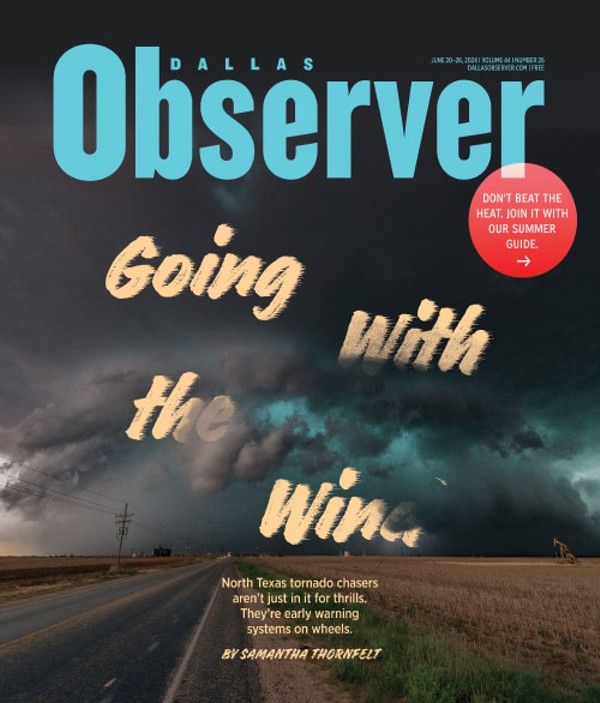Sienna’s peers from Plano Senior High School cheer had organized the candlelight vigil, attended by many of her classmates. Some locked arms as they listened to the event’s speakers.
Sienna’s mother, Stephanie Vaughn, fondly remembers her daughter as a cheerleader with impeccable eyeliner skills and an emo flair, a young woman who was friends with everyone. Dad Ryan Vaughn bonded with Sienna over music, taking her to see Deftones, her favorite band, in concert.
Less than two months earlier, on Feb. 19, Sienna died after taking what she thought was a Percocet, a combination opioid prescription drug. She didn’t know it, but the illicit pill had been laced with a lethal amount of fentanyl.
Fentanyl is a synthetic opioid used to treat severe pain. The state’s health department estimates that since 2019, fentanyl deaths in Texas have spiked more than 500%.
At the vigil, Sienna’s photo appeared on a large pop-up banner, along with pictures of 31 others who’d been “stolen” by the drug. Folding tables were packed with flyers and T-shirts and boxes of Narcan, an over-the-counter nasal spray used to treat opioid overdoses.
A student from Plano Senior High School stood in front of the pavilion. He introduced himself as Julian and said he’d been asked to deliver a sermon about hope. “It’s getting me,” Julian said, his voice faltering, “just to see such a young girl … someone who goes to my school, someone in my community, someone who is affected by this issue — by this plague — that is over this generation, that is over this era of time.”
The world is shifting fast, Julian added.
“Seeing all these things changing,” he said, “seeing people being taken away from us, people going away, it’s — it's scary.”
Sienna was a light to her friends and family and touched many lives. Now she’s part of a growing wave of fatal fentanyl poisonings crashing over the Lone Star State. Carrollton, a neighboring North Texas city, has earned the grim distinction over the past several years of being a hub for fentanyl deaths. Law enforcement announced in early February that a pair of Carrollton dealers had been federally charged in connection with the poisonings of “as many as 10 juvenile[s],” three of which were lethal.
Student after student is succumbing to the synthetic opioid, which is up to 50 times more potent than heroin. According to the Department of Justice, 2 milligrams of fentanyl — the amount that fits on a pencil’s tip, about as much as several grains of salt — could kill.
Victims’ families frequently say they weren’t aware that the drug is being cut into what dealers claim are brand-name prescription pills. Some hadn’t even heard of fentanyl before laying their loved one to rest.
Advocates are blasting school districts for what they see as a lack of action and are warning teens against trusting even their own best friends. Gone are the carefree, often formative days of high-school drug experimentation.
With the sun now almost fully set, Stephanie acknowledged the Plano community for its support in the weeks following her daughter’s death. She warned everyone against thinking that it could never happen to them.
“It doesn't happen on the other side of town. It doesn't happen in a ‘good’ neighborhood. Oh, it can happen to you,” Vaughn said. “You can't smell it. You can't taste it. You don't have any idea it is in your house.
“We had no idea when we went up [to Sienna’s room] I would find my daughter blue on the bed.”
Highly Addictive and Cheap to Produce
Some 100 attendees trickled into the Plano Event Center on March 30 as gray clouds loomed outside. Somber instrumental music played on the auditorium’s speakers at the Plano Police Department’s “Fentanyl Drug Forum.” As the Vaughns walked to their seats up front, Stephanie smiled and waved at another audience member. A pair of women situated close to the stage talked quietly.
“Why aren’t more people here? This is important,” one asked roughly 10 minutes before start-time. And, a few minutes later: “It’s starting to fill up.”
Jeri Horton arrived wearing a purple shirt bearing the photo of a young woman’s face and took a seat on the right side of the elevated stage. Panelists to the left included an emergency room physician and a Drug Enforcement Administration official, who explained how an opioid used to treat hospital patients’ pain has been contorted into a scythe.
It was the first time Horton had spoken publicly about the fentanyl death of her daughter, Jessie. At times during the event, she gently rocked herself side to side.
Horton described her child as a “mama’s girl” with a passion for photography, music and anime. Jessie also struggled with a substance-use disorder, but she didn’t want to die, Horton said. She’d taken what she thought was OxyContin from someone she’d trusted. She didn’t realize that it was actually fentanyl.
“You can't come back from forever.” – Jeri Horton, Plano mother
tweet this
Cases in which law enforcement encountered drugs that tested positive for fentanyl have skyrocketed in recent years, with the number of episodes in the U.S. more than doubling between 2014 and 2015, according to the Centers for Disease Control and Prevention. Texas witnessed a more than 140% spike in synthetic opioid deaths from 2019 to 2020, from 423 fatalities to 1,050.
Guy Baker, with the DEA, explained at the forum that fentanyl makes its way into pills in “clandestine laboratories.” It’s often done in Mexico through cartels in unregulated facilities before crossing over the border. It may be processed locally, he said, adding that the most recent seizure he’d been part of was in a garage, where the pills were made to look like bars of the sedative Xanax or oxycodone, a potent opioid.
“The entire garage of this residence, if you looked at it, was completely full of powder,” Baker said. “There's no control that's taking place in this particular facility. … They've got the pill-press in place, they've got the dyes to make it look like a legitimate pill, and there's no quality control there at all.”
Fentanyl is highly addictive and cheap to produce, and Baker noted that there’s no assurance dealers are using the right amount. “So possibly their intent is not to kill the person,” he said. “Their intent is to make money, and that's why they're pushing these pills into our communities.”
Laura Zimmer, director of counseling services with Plano ISD, advised parents in the audience to monitor or restrict their kids from using social media, which has essentially become the go-to marketplace for illicit drugs. It’s OK to be nosy when it comes to one’s children, she said, adding to watch out for changes in behavior or dips in grades. It may not be substance abuse at the moment, but depression and anxiety can potentially lead to that.
Horton told Plano community members that Jessie knew how dangerous fentanyl was and that she had promised to never use it. Horton also implored parents to tell their kids that they can’t trust anyone when it comes to pills. “Probably the biggest point I want to make is letting your children know that that one choice could be forever,” she said. “You can't come back from forever.”

Sienna’s memorial program is displayed next to the urn holding her ashes at her home in Plano.
Alicia Claytor
A Local History of Drug Deaths
This isn’t the first time that drugs have fueled a community crisis in Plano.
In August 1998, then-student Kristin Holt from Plano Senior High School helped put together a candlelight vigil honoring teens who’d fallen victim to heroin. “I'm glad we’re ending our senior year with no more deaths, and we’re coming to a close,” 17-year-old Holt told The Dallas Morning News at the time. A string of heroin-related fatalities that had rocked the wealthy Dallas suburb for years was finally starting to wane.
More than a dozen local high-school and college students, described by the news media as “clean-cut teenagers'' with promising futures, had died from the drug in the late 1990s, according to a 2015 article in the Journal of American History. Heroin, once thought to afflict mostly urban areas, had begun to encroach on an affluent North Texas enclave with gated communities.
Collin County’s medical examiner logged at least eight deaths from heroin overdoses between 1987 and the last month of 1995, the Dallas Observer reported in May 1999. Most of the casualties had been hardcore drug users in their late 30s. But the victims’ ages began to drop: from 27 to 21, and then to an average of 18. Outlets like MTV and Newsweek reported splashy stories about the teen junkies of suburbia.
Undocumented immigrants and Mexican cartels bore the brunt of the blame for the heroin, called “chiva,” making its way to suburban kids, the Journal of American History reported. But 16 of the 29 so-called drug pushers indicted in connection with the fatal overdoses were white teens themselves who had hawked heroin to their peers. (The Observer wrote at the time that chiva is “a blend of heroin and antihistamines,” either injected or snorted.)
From 1995 to 1999, at least 19 young people succumbed to heroin in Plano, the Observer reported last year. Some North Texas residents have drawn comparisons between the Plano heroin epidemic of the mid- and late-’90’s and today’s fentanyl scourge. The untimely — and seemingly unending — deaths have put entire communities on edge.
Retired detective Billy Meeks recalled his time as commander of the Plano heroin task force. Asked his thoughts on today’s rash of fentanyl deaths, he was quick to say, “It’s the same way.” A small amount of the high-octane drug “was overdosing everybody,” he said, and it came into Texas from Mexico.
“We had a lot of kids dying that didn't even know what chiva was,” he said.
The Collin County Substance Abuse Program, established in 1990, has recently seen an “alarming” increase in the number of fentanyl-related deaths, from 29% of all drug overdose deaths in 2020 to 55% last year, program administrator John-Mark Meulman said during the March forum. “For those of you that were here [in the 1990s] and remember that, heroin was the drug problem back then,” he said. “It was a pervasive problem, and there were forums like this about that back then.”
Ryan has heard people cite parallels between the two North Texas drug eras. It makes sense to draw analogies, said Vaughn, who was a high school student in Richardson at the time of the heroin epidemic. He remembers seeing the crisis plastered on the national news. Upset parents filled gyms then, too.
“To that degree, there's similarities: The community’s scared, people are very fearful,” Vaughn said. But when it comes to the heroin users, “They were intentionally making a decision to do something that was dangerous.”
“We had a lot of kids dying that didn't even know what chiva was.” – Billy Meeks, retired Plano detective
tweet this
The language surrounding fentanyl deaths is important to people like Sienna Vaughn’s family. They’ll refer to their loved one as having been “poisoned” instead of calling it an “overdose.” One advocate explained that the latter term implies that someone has taken more of a drug than they’re supposed to. Yet some have lost their lives to fentanyl after taking only half a pill.
It’s possible that some students today may also realize that they’re taking a risk by experimenting with prescription meds, Ryan said. “But most of them, I think, like Sienna, did not know what she was [taking] and was tricked, and she was poisoned,” he continued. “That’s the difference.”

Bracelets honoring Sienna read "One Pill Can Kill" and "#siennasstory" on the outside. On the inside, it says "Spread The Word And Save A Life."
Alicia Claytor
A glittering black box tinged lightly with pink and bearing Sienna’s name rested on the Vaughns’ dining room table in their home on a Plano cul-de-sac. It’s an apt representation of Sienna, whose multifaceted personality didn’t fit into just one category. Yes, she liked heavy music and was proud of her piercings, but she’d also been a Girl Scout and was a “closet Swiftie,” her mom said, referring to fans of Taylor Swift. Sienna loved driving her little blue Kia, which her parents had gotten because of its impressive safety features. It was parked outside the Vaughns’ home one Wednesday afternoon in early April.
Stephanie now thinks that she was “worried about the wrong things.
“I was worried about her getting in a car accident,” she said. “I even told her, ‘I know you're not to the age yet, but don't accept any drinks, you know, because of roofies.’ Women have a lot to be warned about. But, I wish I would have known to say, ‘Hey, Sienna, all that other stuff is important too, but this can kill you the first time.’”
The Vaughns’ younger daughter, Summer, crafted the box to hold cherished memories that mourners could write down during Sienna’s funeral. The service was packed, Stephanie said, and some teens have since told her that Sienna had lifted them up during difficult days at school. Like many of her friends, Sienna had also struggled with mental health. She wanted to become a counselor.
Today, Sienna’s ashes rest in an elegant dark blue urn in the Vaughns’ living room.
As Stephanie sat at the long dining table, she stroked a fluffy black lapdog named Coco Chanel. She recalled that Sienna was a good writer who loved animals, particularly the kittens the family fostered during the coronavirus pandemic. Sienna likely would have been “really upset” at the recent acquisition of Coco, her mother joked. “I know she's probably pissed at that. ‘You got a dog for Summer? I would’ve been asking for a dog forever.’”
Sienna’s mother is devastated by the loss of her daughter. She’s also furious — angry at society for getting to this point, mad at Sienna’s school for not doing enough. Plano has a reputation to uphold as having the best schools, she noted, but kids are purchasing pills on campus from other students. The administration doesn’t want to admit that there’s an issue with drugs like fentanyl, she said.
Since Sienna’s death, the Vaughns have spoken to several media outlets, hoping to raise awareness about the crisis that claimed their daughter. They had tried their best to protect Sienna from the synthetic opioid. Stephanie even warned her against taking fentanyl pills. But what they didn’t know at the time was that other pills, like those billed as Xanax and Percocet, would serve as a sort of “Trojan horse” for fentanyl. They didn’t know that the imposter drug would look just like the real thing.
The issue is cropping up in other states. The New York Times reported last May that two Ohio State University students had died after ingesting pills disguised as Adderall, a drug used to treat attention deficit disorder that’s popular among college kids who use it as a study aid.
On the way to a recent dance competition, one of Summer's friends, who had hurt her ankle, asked for Advil. Stephanie then reminded the girl that taking medication from a trusted friend is how Sienna got killed. “It could be Advil next time. It could be Tylenol,” she recalled telling Summer’s friend. “Everybody has to get into this mindset: No pill from anyone except your parents.”
On the night of Sunday, Feb. 19, the Vaughns had visitors from out of town. Sienna’s close friend was over, and the pair was eating sugary snacks and goofing around. At some point, they went upstairs to Sienna’s room. Stephanie estimates they’d been gone for around an hour and a half before she knocked on the door to ask Sienna a question. No answer.
“I was worried about her getting in a car accident. I even told her, ‘I know you're not to the age yet, but don't accept any drinks, you know, because of roofies.’ – Stephanie Vaughn, Sienna Vaughn's mother
tweet this
She knew that something was wrong as soon as she saw the girls. Sienna was “so, so pale” and her friend was making a gurgling sound. Stephanie yelled “call 911!” and performed CPR on her daughter. Medical workers were unable to revive Sienna, although her friend survived.
Despite this, Sienna’s mother finds a sort of comfort being in her daughter’s room, which looks nearly the same as it did on the night of her death. The popcorn that had been strewn all over the floor was swept up, but Sienna’s towel is in the same spot on the ground and her bed remains unmade. In the days after Feb. 19, Stephanie would wear the black hoodie that Sienna had loved because it smelled like her. But, Stephanie said with tears in her blue eyes, that scent has started to fade.
A Lack of Knowledge
Stefanie Turner was emotional on the night of Sienna’s candlelight vigil. It’d been 18 months since the Austin mom had attended a memorial. That one was for her son, 19-year-old Tucker Roe.
Roe was an adventurer and a “spiritual deep thinker” with a huge heart, his mom recalled. After losing him to fentanyl poisoning, Turner felt compelled to share his story: There were things she wished she had known and things she felt she could have done. The lack of fentanyl education and awareness led her to form a nonprofit organization called Texas Against Fentanyl. The Vaughns are involved now, too.
Turner explained at the vigil that Roe was always drug-curious. He’d started smoking weed in 8th grade to help cope with stress. But at a New Year’s Eve party in 2021, a year when fewer people knew about the dangers of fentanyl, someone offered Roe a pill that appeared to be Xanax, thereby spurring an addiction.
After staying sober for a few months, Roe bought what he thought was a Percocet pill on social media, and it killed him.
“What I didn't know is what happens in the brain when you take one of those pills,” Turner told the Plano vigil attendees. “And for the record, 99% of all pills seized by the DEA contain fentanyl — 99% of pills. So, if you guys are buying a pill off of any social media, anything — if it doesn't come from a pharmacy or a doctor, count on it having fentanyl. It has fentanyl. And 60% of those pills contain a lethal amount.”
Turner told the Observer that the biggest barrier to combating the fentanyl epidemic is a lack of knowledge. The only people who understand it are those who’ve been through it, she said. Ask pretty much any high school kid if they want to try heroin, and they’ll decline, Turner added. She hopes that more awareness will help to create the same automatic refusal when it comes to illicit pills.
Lawmakers in the Texas Legislature are beginning to turn their attention to the fentanyl crisis. A proposal that would decriminalize fentanyl test strips was overwhelmingly approved by the Texas House earlier this month. And House Bill 3908, by Republican state Rep. Terry Wilson, would require fentanyl education for grades 6 through 12. It’s titled “Tucker’s Law.”
Turner said she’s “honored” that her son is the bill’s namesake: “I'm very proud that his life will save others.”
Earlier this month, Turner joined Gov. Greg Abbott at the One Pill Kills Summit in Austin. Abbott announced a $10 million awareness initiative focused on prevention and recognition as part of a statewide campaign. He also unveiled his plan to equip each of Texas’ 254 counties with Narcan.
Losing your loved one to fentanyl is a life-altering event that the Vaughns and Turner are fighting to keep from happening to anyone else. It’s been difficult for Stephanie to relive the night of her daughter’s death. “We didn't want to do any [interviews], actually,” she said, “but if it can hopefully save another kid's life, we had to at least go public.”
When the Vaughns had finished speaking at the vigil, one of Sienna’s best friends stepped up to sing. Attendees lit candles, sometimes using their own fire to touch off a neighbor’s wick. The sky was now jet-black and the temperature had dropped, but the Plano streetlights shone brightly as the teen finished the tribute. Afterward, the crowd dispersed, and families trudged back to their cars.
One by one, Sienna’s friends and former classmates blew out their flames. Stephanie and Turner wrapped one another in a long, warm embrace.














